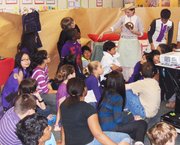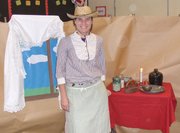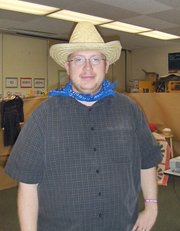Teacher Maggie Brown addresses Rocky Run seventh-graders as Nebraska homesteader Prairie Annie. Photo by Bonnie Hobbs.
Rocky Run seventh-grade history teacher Maggie Brown stacked the desks in her classroom on top of each other. She then covered the with brown paper to simulate a sod house and had her students sit on the floor inside it.
Then, dressed as Prairie Annie, who’d lived in the 1860s and 1870s, she taught the children about that part of the Westward Movement. She showed them slides of things including wagon trains and land and spoke in an accent as she explained what life was like for the new settlers.
“Prairie Annie and her husband moved from Virginia to Omaha, Neb., and got land from the U.S. government as part of the Homestead Act,” said Brown. “They paid $10 for 160 acres. And because there were no trees where they lived, they built a sod house for them and their seven children.”
Brown was one of four history teachers participating in the seventh grade’s recent Westward Movement experience. Students rotated among each teacher’s class to learn different aspects of the westward expansion in America in the 1870s and 1880s, after the Civil War.
Dressed as a Pocahontas character called “Pocostello,” teacher Jeannie Costello discussed Native Americans. Teacher Jamie Sawatsky became a Thomas the Tank Engine-type character called “The Iron Horse” and taught about the railroads. And decked out in a cowboy hat and kerchief was teacher Daniel Vroman as “Cowboy Vroman,” telling students about the role of the cowboys.
The Homestead Act was passed in 1862 and, said Brown, “It was the first time women had the right to own land. But Confederate soldiers couldn’t get land through this act because they’d fought against the U.S. You had to build a house and cultivate that land and, after five years, the government would give you the deed to the land.”
Since it hardly ever rained in Omaha, settlers there had to learn dry farming. The soil was so rocky that steel plows were invented to tackle it. “So we dig our seeds way down in the soil where there’s water,” said Brown as Prairie Annie. “We don’t have to worry about water from the sky.”
Praising barbed wire, she called it “the best thing that happened to settlers because it keeps the cows out of our homes and property.” However, she added, there was no indoor plumbing and outhouses were built far from the homes. And when a dust storm blew up, layers of dust covered everything.
“We get so excited when the Sears & Roebuck catalogue comes so we can order things out of it,” said Brown. “When we’re through with it, we take it to the outhouse. And do you know what we do with it?” A student answered, “Read it?” Nope, she replied; “We use it for toilet paper.” She also noted that buffalo “chips” were used for fuel to build fires to heat their houses. And she had her students act out various scenarios, pretending to be, for example, a cowboy upset about the barbed wire the farmers had put up.
Brown said the farmers grew corn and wheat and added it to meals with vegetables, dried fruits and milk. “We rely on our neighbors,” she added. “We can’t survive without each other.” As for school, she said, “All grades were together with the same teacher in a one-room, sod schoolhouse. Students walked a half-mile or more to school barefoot, until the freezing weather, because their shoes came from the catalog.”
After her class, student Audrey McCleary said she learned “how it wasn’t easy and what everyone had to do to survive. The toughest part was starting out and trying to make everything from scratch. I didn’t know about [that part of American history] and it was fun to have the visual character of Prairie Annie.”
Deonja McCrimmon learned that “it was hard to make the crops grow; corn was the easiest. And when there were dust storms, you had to put ropes on each side of the house to find your way from one place to the other. Boys weren’t allowed to wear shoes [every day] because they’d tear them up in two days flat. And children ate bread and lard for lunch.” So would she have liked to have lived back then?” Replied Deonja: “No; it would be too hard.”
Patricia Edouard said it was difficult for the homesteaders to settle into their new lives. “You had to send your kids one-and-a-half miles to school, so you’d be worried about them,” she said. Patricia enjoyed learning this way, rather than just reading about this time period in a textbook. “In a book, it would be just plain facts,” she said. “But seeing it in a different perspective gives you a new feel about it.” “I found it fascinating and weird that they found sod more comfortable than wood houses,” said Shreya Menon. “I’d want to have my school close by; I’m sorry, but I don’t want to walk a half-mile. And the outhouses? That’s disgusting; I couldn’t do that.”
Learning about the Westward Movement via slides, reenactments, music and costumed teachers was “attention-grabbing,” added Shreya. “You’re really listening, and I learned fun facts, like people straightening their hair with irons. If I were the mom, though, I’d fear for my family, ’cause I’m not a good cook.”
“We’ve also reenacted the Electoral College – the 1876 Rutherford B. Hayes and Samuel J. Tilden presidential election signifying the end of Reconstruction,” said Brown. “The students watched a video I made about it and then ‘were’ the Electoral College and looked at the Southern Democrats’ solution to Reconstruction.”
“The best way to learn history is to ‘live’ through it,” she continued. “I also apply it to the students’ regular lives so they can relate to it better and it’s not just a lot of boring, old facts.”



